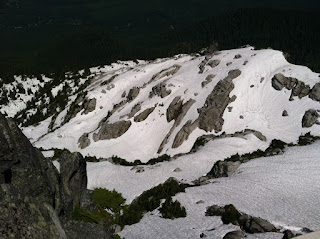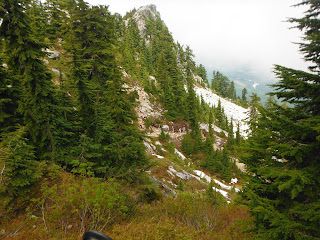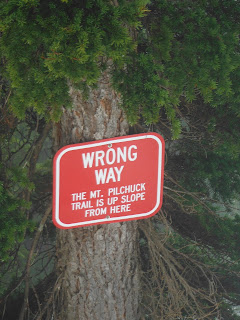 |
| Mt. Pilchuck snowcapped in Spring |
 |
| Pilchuck in Autumn |
To get to the trailhead, take the Mountain Loop Highway ten miles out of Granite Falls. The turn off to the seven mile access road is just past the bridge, on the right side of the road, less than a mile past the Verlot Ranger Station. Stop in Verlot if you need to renew your Northwest Forest pass.
The road to the trailhead can be a washboard mess though the last couple of summers, it's been pretty good. Your mother's Buick could have taken us to the parking lot when we headed up at the end of June 2015. This year, there were some potholes that might swallow a Smartcar, though a school bus made the trek.
There's a privy at the trailhead, but no guarantee it'll be stocked with TP. Register your party a hundred yards up the trail. Causal hikers will be amused by the warning sign ignored by many.

The trail goes up right away, first climbing a forested ridge, crossing a rocky avalanche field, then turning out of the woods for great views of Three Fingers. Above the heavy forest, you'll edge into the open old ski bowl and cross through the big chair remains. Your trip to the summit will be a little more work than those early skiers taking on the Cascade Crud of the 1960s. The trail in winter goes almost straight up. As the snow melts out, it switches back to the north where it ascends the summit block. A couple more rock slides and a bonsai spruce forest open up to the historic look out on the summit.
To access the look out requires a little bit of scrambling over boulders and a climb up a short ladder. This can prove to be a challenge if you are hiking with small children or dogs. Once you reach the look out, you'll enjoy panoramic views with plaques to help identify distant peaks and little history of the place.
 |
| The Look Out Approached from the Snow Route |
 |
| Instagram Beauty from the top |
The number of the inexperienced people we saw on the trail yesterday probably out numbered old sourdoughs ten to one, One group of twenty-somethings only had a 12 oz sports drink bottle to share with each other. It was empty by the time they got to the top. On a mild and partly cloudy day, they were only a little thirsty. When I asked if they wanted some water, they said, "No, we drank from a little stream that crosses the trail."
I warned them about giardia. They didn't believe me, "Is that a thing?" A microscopic, cysty-thing. They appeared young and fit, wearing only workout clothes and running shoes. One of boys told me that they came up last year and it was really slippery. Naturally, they didn't pack a warm jacket, rain gear, or even a granola bar. None carried a knapsack. I am certain they got back to the parking lot fine. Time will tell if giardia will strike.
From late October or November, through May and even June, Mt. Pilchuck can be snow capped. After all, it used to be a ski area. As late as early July, it can make an adventurous day hike that takes you from the shadowed forest across rocky avalanche fields, and through several feet of snow to the historic look-out on top. A few weeks later, after all the snow is melted from the trail, the climb to the summit can be knocked out by the super-fit in less than an hour. For the rest of us, in mid-summer form, it can be crowned in under two hours.
 |
| Snow in early July of 2013 started a mile past the parking lot. |
 |
| Snow in late June of 2016 at 5080 ' |
The ill-prepared couple were also surprised to find out the historic look out didn't come with a heater. We know this because they wrote angry graffiti on the walls. When we arrived just after Search and Rescue got to them in the morning, smoke lingered from their attempt to warm themselves by a fire. This was problematic since the look out doesn't have chimney. They're lucky they didn't asphyxiate themselves or burn down the beloved fire look out.
 |
It turns out this is only angry graffiti and not
the last will and testament of the ill-prepared couple
|
This might be an appropriate time to think about trip planning and the ten essentials. Here's a list from The Mountaineers:
 |
Courtesy of the The Moutaineers,
|
A warm jacket to put on when you stop prevents discomfort at cooler elevations, it might also prevent hypothermia. No need to start a fire in a treasured landmark. Clean and safe water will make even a short hike more pleasant. If you are hiking with kids, stop and drink water on the way up. Don't drink from streams or lakes without filtration. In July and August, you can suffer from heat stroke even on the west side of the Cascades.
 |
| The football team momentarily on the trail |
I was proud of my normally mild-manner friend, Warren, who called out a crew of twenty-somethings cutting the Lake 22 trail earlier this month. It's one thing to be 16 year-old boy trying to prove you're the top dog. By 26, you really should know better. Trail cutting demonstrates not only a selfish disregard for nature and others, but a complete lack of imagination to think that you're the only git to go bushwacking and to not comprehend the impact of a thousand gits every summer doing the same thing.
Ditto for speakers on your pack. I love music, but in the woods, I want to hear birds, wind, and perhaps the growl of a black bear. I don't want to hear your German metal or latest hiphop dance beats. If the solitude frightens you, and you need the comfort of an urban lullaby, wear headphones.
Mt. Pilchuck is an awesome hike. It's no wonder the maddening crowds throng in. With a little consideration for others, and a bit of preparation we can all have a safe and enjoyable time on the mountain.










